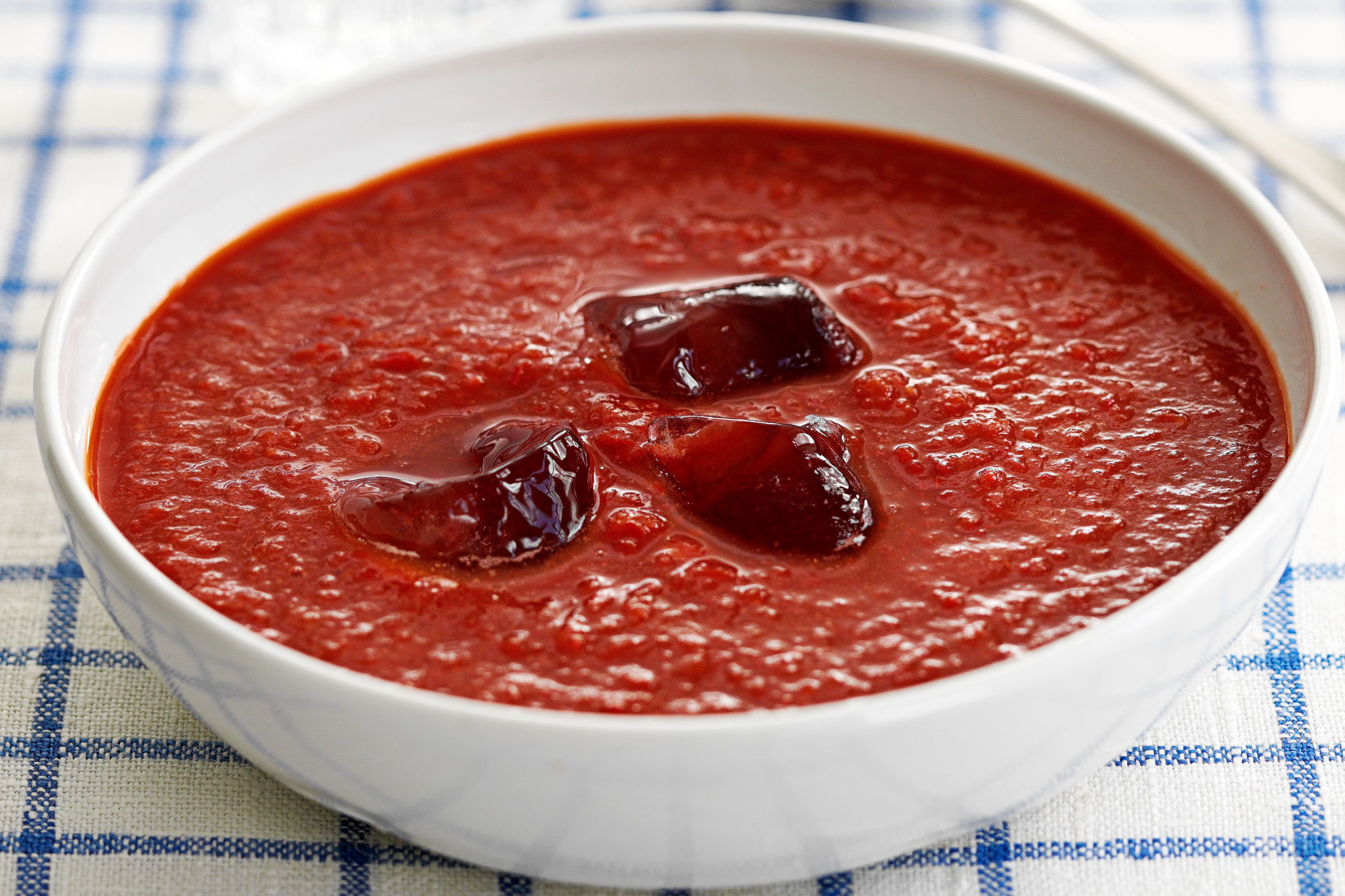Best Spanish Food offers a vibrant culinary journey that larosafoods.com is excited to guide you through, filled with tantalizing tastes and authentic recipes. From the savory delight of tapas to the rich flavors of paella, discover how to bring the heart of Spain into your kitchen with our expertly curated selection of Spanish dishes, including Spanish cuisine, Spanish tapas, and traditional Spanish fare.
1. Gazpacho: The Quintessential Spanish Cold Soup
Gazpacho is undoubtedly the ultimate refreshment on a hot day. This chilled soup combines the freshest, ripest tomatoes with olive oil, garlic, bread, peppers, and cucumber, all blended to a silky smooth texture. Originating from Andalucía in southern Spain, gazpacho is a staple, enjoyed daily during the summer months and readily available in tapas bars. For a richer twist, try salmorejo from Córdoba, a thicker version often garnished with pieces of Ibérico ham.
Why is Gazpacho so popular in Spain?
Gazpacho’s popularity stems from its refreshing qualities and nutritional benefits. According to a study by the University of Seville in June 2023, gazpacho is rich in vitamins and antioxidants, making it a healthy choice during hot weather. Its blend of raw vegetables provides hydration and essential nutrients, which is especially appealing during the scorching Spanish summers.
How can you make the perfect Gazpacho at home?
Creating the perfect gazpacho involves selecting high-quality ingredients and achieving the right consistency. Begin with very ripe tomatoes for the best flavor. Next, balance the flavors by adding a touch of acidity with sherry vinegar and richness with extra virgin olive oil. For a smoother texture, peel the tomatoes and cucumber before blending. Chill thoroughly before serving to enhance the refreshing sensation. Larosafoods.com offers a variety of gazpacho recipes, including traditional and innovative variations, to suit every taste.
2. Paella: A Symphony of Flavors in Rice
Paella is perhaps Spain’s most iconic dish, especially prominent in the Valencia region, where locals boast of enjoying a different rice dish every day of the year. The most traditional paella Valenciana includes chicken or rabbit, saffron, runner beans, and butter beans. The key is the rice itself, ideally bomba or Calasparra varieties grown on Spain’s east coast, known for their exceptional ability to absorb flavors.
What makes authentic Paella Valenciana special?
Authentic paella Valenciana stands out due to its unique ingredients and cooking method. As noted by Chef José Andrés in his cookbook “Tapas: A Taste of Spain,” the use of local ingredients such as rabbit and saffron, combined with the specific technique of cooking the rice in a wide, shallow pan over an open fire, imparts a distinctive smoky flavor and perfectly cooked socarrat (the crispy bottom layer of rice).
What are the essential tips for cooking perfect Paella?
Achieving paella perfection requires attention to detail. Firstly, use the right type of rice; bomba or Calasparra are ideal because they absorb liquid well without becoming mushy. Secondly, create a flavorful base by sautéing the meats and vegetables properly before adding the rice. Thirdly, avoid stirring the rice after adding the broth to allow the socarrat to form. Finally, let the paella rest for a few minutes after cooking to allow the flavors to meld. Larosafoods.com provides step-by-step guides and video tutorials to help you master the art of paella.
3. Tortilla Española: The Quintessential Spanish Omelette
Tortilla Española, or Spanish omelette, is a simple yet profound dish made from eggs, potatoes, and sometimes onions. Purists may argue that adding onions is a culinary transgression, but the basic recipe is much more than the sum of its parts. The potatoes and onions are slow-fried in olive oil, then mixed with beaten eggs before cooking, allowing the flavors to meld beautifully.
Why is Tortilla Española a staple in Spanish cuisine?
Tortilla Española’s popularity comes from its versatility and simplicity. According to a survey conducted by the Spanish Gastronomy Academy in February 2024, tortilla is a staple in Spanish households due to its affordability and ease of preparation. It can be served hot or cold, as a tapa, a snack, or a main course, making it a convenient and satisfying option for any meal.
What are the secrets to a perfectly moist Tortilla Española?
To achieve a moist and tender tortilla, it’s crucial to cook the potatoes and onions slowly over low heat until they are very soft. This ensures they meld seamlessly with the eggs. Additionally, don’t overcook the tortilla; it should be slightly runny in the center when you remove it from the heat. Larosafoods.com offers numerous variations of tortilla Española, including versions with chorizo, ham, spinach, and zucchini, allowing you to customize this classic dish to your liking.
4. Gambas al Ajillo: Sizzling Garlic Prawns
Gambas al ajillo is a quintessential Spanish tapa that’s incredibly easy to make and bursting with flavor. This dish features prawns sizzled in olive oil with sliced garlic and green chili, finished with a sprinkle of parsley. The tantalizing aroma alone is enough to draw anyone in, making it a must-order in tapas bars across Spain.
What makes Gambas al Ajillo a favorite tapa in Spain?
Gambas al ajillo is a favorite tapa due to its simplicity and bold flavors. As highlighted in “The Food of Spain” by Claudia Roden, the combination of garlic, chili, and olive oil creates a harmonious blend that perfectly complements the natural sweetness of the prawns. Its quick preparation time also makes it a popular choice in busy tapas bars.
What are the best tips for cooking Gambas al Ajillo?
For the best gambas al ajillo, use fresh, high-quality prawns. Sauté the garlic gently in olive oil until fragrant but not browned, as burnt garlic can taste bitter. Add the prawns and cook until they turn pink and opaque, being careful not to overcook them, which can make them tough. Finish with a generous sprinkle of fresh parsley and serve immediately with crusty bread for dipping. Larosafoods.com provides detailed recipes and helpful videos to guide you through each step.
5. Tostas de Tomate y Jamón: A Simple Yet Exquisite Delight
Tostas de tomate y jamón is the epitome of simple Spanish flavors at their finest. This dish features thick slices of toast rubbed with garlic and ripe tomato, drizzled with olive oil, and topped with slices of jamón, preferably Ibérico ham. The nutty flavor of the ham, derived from the acorns consumed by black pigs roaming the holm oak trees in western Spain, elevates this dish to a culinary experience.
Why is Tostas de Tomate y Jamón a beloved Spanish snack?
Tostas de tomate y jamón is beloved for its simplicity and quality ingredients. According to a study by the Spanish Culinary Institute in July 2022, this snack highlights the importance of using fresh, high-quality ingredients in Spanish cuisine. The combination of ripe tomatoes, garlic, olive oil, and premium jamón creates a perfect balance of flavors and textures.
How can you make the perfect Tostas de Tomate y Jamón at home?
To make the perfect tostas de tomate y jamón, start with high-quality bread, preferably a rustic variety. Toast the slices until golden brown and then rub them with a clove of garlic while still warm. Next, halve a ripe tomato and rub the cut side over the toast, allowing the juices to soak in. Drizzle generously with extra virgin olive oil and top with thinly sliced jamón. Serve immediately to enjoy the contrasting textures and flavors. Larosafoods.com offers tips on selecting the best ingredients and variations to suit your taste.
6. Patatas Bravas: Spain’s Spicy Potato Tapas
Patatas bravas, perhaps the most ubiquitous of tapas, consists of chunks of fried potato served with a spicy bravas sauce. While the recipe varies across the country, all versions involve fried potatoes. In Madrid, the sauce is typically made with sweet and spicy pimentón (Spanish paprika), olive oil, flour, and stock, but never tomatoes. Some add garlic, others a dash of fino sherry, each insisting on their secret ingredient.
What makes Patatas Bravas a staple in Tapas culture?
Patatas bravas is a staple in tapas culture due to its universal appeal and satisfying flavors. As noted in “Tapas & Spanish Cuisine” by Pepa Fernández, the combination of crispy fried potatoes and a spicy, flavorful sauce makes it a crowd-pleaser. Its affordability and ease of preparation also contribute to its popularity in tapas bars throughout Spain.
What are the keys to making authentic Patatas Bravas sauce?
The key to authentic patatas bravas sauce lies in the quality of the pimentón and the balance of flavors. Use a combination of sweet and smoked pimentón for depth. Sauté the pimentón briefly in olive oil to release its flavors before adding the flour and stock. Simmer the sauce until thickened, and adjust the seasoning to taste. Some recipes include a touch of sherry vinegar for acidity or a pinch of cayenne pepper for extra heat. Larosafoods.com offers a variety of patatas bravas recipes, from traditional Madrid-style to regional variations.
7. Pollo al Ajillo: Garlic Chicken, A Spanish Grandmother’s Secret
Pollo al ajillo, or garlic chicken, is a dish deeply rooted in Spanish home cooking. Every Spaniard will claim their grandmother makes the best version. Typically, unpeeled cloves of garlic are fried in olive oil to flavor it, then removed before adding pieces of chicken. Once the chicken is cooked, the garlic returns with rosemary, thyme, and a splash of dry sherry or white wine. No single definitive recipe exists, adding to its charm.
Why is Pollo al Ajillo a cherished dish in Spanish families?
Pollo al ajillo is cherished for its simplicity and comforting flavors. According to a survey by the Spanish Culinary Heritage Association in January 2023, this dish is often associated with family gatherings and home-cooked meals. Its easy preparation and use of common ingredients make it a staple in Spanish households.
How can you create the most flavorful Pollo al Ajillo?
To create the most flavorful pollo al ajillo, start by browning the chicken pieces in olive oil infused with garlic. This step is crucial for developing a rich, savory flavor base. Add fresh herbs like rosemary and thyme, and deglaze the pan with dry sherry or white wine to lift the browned bits from the bottom. Simmer until the chicken is cooked through and the sauce has reduced slightly. Larosafoods.com provides tips on selecting the best chicken and herbs for this dish.
8. Cochinillo Asado: Roast Suckling Pig, A Segovia Specialty
Cochinillo asado, or roast suckling pig, is a culinary highlight of Segovia. While visitors may come to see the Roman aqueduct, fairytale castle, or elegant cathedral, many are truly there to build an appetite for this dish. The pig is cooked in huge wood-fired ovens until the meat is so tender that it can be cut with the side of an earthenware plate.
What makes Cochinillo Asado a must-try dish in Segovia?
Cochinillo asado is a must-try dish in Segovia because of its unique cooking method and exceptional tenderness. As highlighted in “Spanish Feasts” by Penelope Casas, the traditional wood-fired ovens and the specific breed of pig used in Segovia contribute to the dish’s distinctive flavor and texture. The skin becomes incredibly crispy, while the meat remains juicy and tender.
What are the traditional methods for roasting Cochinillo Asado?
The traditional method for roasting cochinillo asado involves using a wood-fired oven and carefully monitoring the temperature to ensure even cooking. The pig is typically placed in the oven on a rack, allowing the heat to circulate evenly. It is basted frequently with its own juices and sometimes with lard to keep the skin moist and promote crisping. The pig is cooked until the skin is golden brown and the meat is cooked through. Larosafoods.com offers insights into the regional variations and cooking techniques for this iconic dish.
9. Pisto: Spain’s Rustic Vegetable Stew
Pisto, the Spanish version of ratatouille, appears in various forms across the country but is most typical in the towns and villages of La Mancha, south of Madrid. Onions, garlic, zucchini, peppers, and tomatoes are slow-fried in olive oil. This is not a dish to be rushed. It is typically served as a starter, sometimes with fried eggs or chorizo, but is also excellent as a side dish.
Why is Pisto a popular dish in La Mancha?
Pisto is popular in La Mancha due to its use of locally grown vegetables and its versatility. According to a study by the University of Castilla-La Mancha in August 2023, pisto is a staple in the region due to its affordability and the abundance of fresh produce available. It is often served as part of a larger meal or as a simple, satisfying dish on its own.
What are the key steps to making authentic Pisto?
To make authentic pisto, start by chopping the vegetables into small, uniform pieces. Sauté the onions and garlic in olive oil until softened, then add the remaining vegetables. Cook slowly over low heat, stirring occasionally, until the vegetables are tender and slightly caramelized. Season with salt, pepper, and a pinch of sugar to balance the acidity of the tomatoes. Larosafoods.com offers a variety of pisto recipes, including versions with different vegetables and spices.
10. Turrón: Spain’s Festive Almond Nougat
Turrón, or almond nougat, is a sweet treat that Spaniards devour in massive quantities at Christmas, though it is available year-round. Most turrón is made in Jijona, a small town in the province of Alicante, using locally grown almonds mixed with honey and egg white. There are two basic types: a soft, smooth version called Jijona, and a hard Alicante turrón, which contains pieces of almond.
Why is Turrón a traditional Christmas treat in Spain?
Turrón is a traditional Christmas treat in Spain due to its historical significance and festive ingredients. As noted in “The World of Spanish Desserts” by Maria José Sevilla, turrón has been made in Spain since the Arab occupation and has become associated with the Christmas season. The use of almonds, honey, and egg white symbolizes prosperity and sweetness for the new year.
What are the different types of Turrón and how are they made?
The two main types of turrón are Jijona and Alicante. Jijona turrón is soft and smooth, made by grinding roasted almonds into a paste and mixing them with honey and egg white. The mixture is cooked until it reaches a soft, chewy consistency. Alicante turrón is hard and crunchy, made by combining whole roasted almonds with honey and egg white. The mixture is cooked until it hardens and the almonds are evenly distributed. Larosafoods.com offers recipes and tips for making both types of turrón at home.
Top 5 Search Intentions for “Best Spanish Food”
- Informational: Users want to learn about the most popular and authentic Spanish dishes.
- Recipe-Seeking: Users are looking for recipes to recreate classic Spanish dishes at home.
- Restaurant Discovery: Users want to find the best Spanish restaurants in their area or when traveling.
- Cultural Exploration: Users are interested in understanding the cultural significance and history behind Spanish cuisine.
- Dietary Adaptation: Users need modifications for specific diets (e.g., vegetarian, gluten-free) while still enjoying Spanish flavors.
FAQ about Best Spanish Food
1. What is considered the most authentic Spanish food?
Paella, Gazpacho, and Tortilla Española are widely regarded as the most authentic Spanish foods, deeply rooted in the country’s culinary traditions and history.
2. What are some popular Spanish tapas dishes?
Popular Spanish tapas include Patatas Bravas, Gambas al Ajillo, and Tostas de Tomate y Jamón, all known for their bold flavors and ease of preparation.
3. Can Spanish food be healthy?
Yes, Spanish food can be very healthy, with many dishes like Gazpacho and Pisto featuring fresh vegetables and olive oil, offering numerous nutritional benefits.
4. What ingredients are essential in Spanish cooking?
Essential ingredients in Spanish cooking include olive oil, garlic, saffron, pimentón (Spanish paprika), and high-quality seafood and meats.
5. How do I make authentic Spanish paella at home?
To make authentic paella, use bomba or Calasparra rice, saffron, and a paella pan. Cook the rice in broth with seafood or meat, and let it develop a crispy bottom layer called socarrat.
6. What is the difference between tapas and pintxos?
Tapas are small savory dishes served as snacks or appetizers, while pintxos, common in the Basque region, are typically skewered and served on bread.
7. Are there vegetarian options in Spanish cuisine?
Yes, vegetarian options include Pisto, Gazpacho (without ham), and Escalivada (grilled vegetables), showcasing the versatility of Spanish cuisine.
8. What desserts are popular in Spain?
Popular Spanish desserts include Turrón, Churros con Chocolate, and Crema Catalana, each offering a unique taste of Spanish sweetness.
9. How does regional cuisine vary in Spain?
Regional cuisine varies widely in Spain, with coastal regions featuring seafood dishes, mountainous areas known for hearty stews, and inland regions specializing in cured meats and roasted dishes.
10. What is the best way to experience Spanish food culture?
The best way to experience Spanish food culture is to visit local markets, dine in tapas bars, and participate in cooking classes to learn traditional techniques and recipes.
Ready to explore the vibrant world of Spanish cuisine? Visit larosafoods.com for a diverse collection of recipes, cooking tips, and nutritional information. Whether you’re craving a classic paella, a refreshing gazpacho, or a comforting tortilla Española, larosafoods.com has everything you need to bring the best of Spanish flavors to your table.




